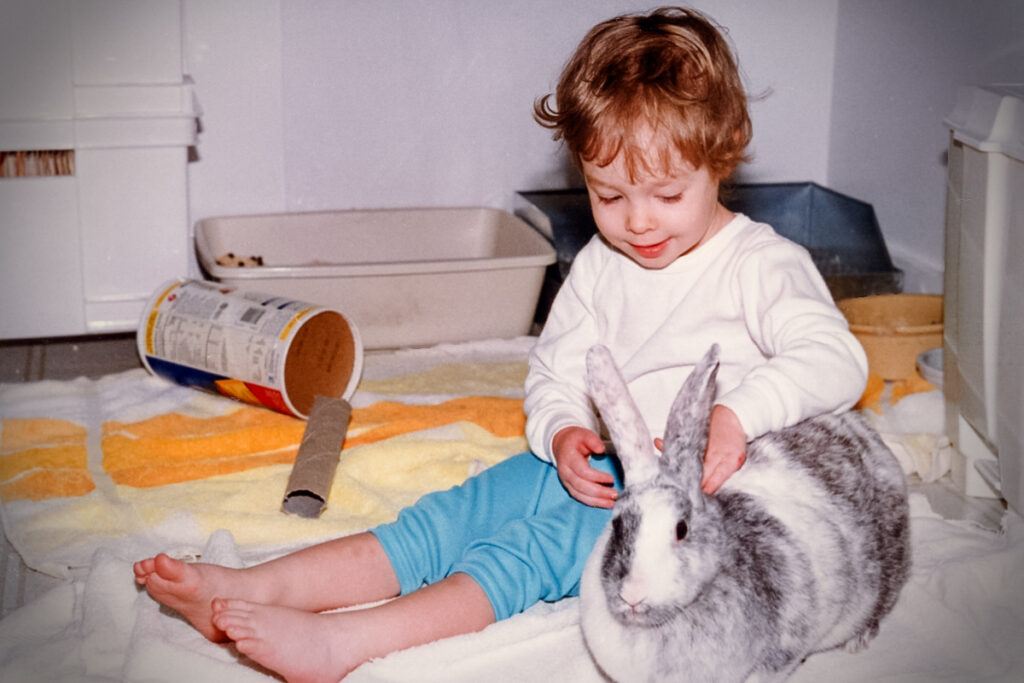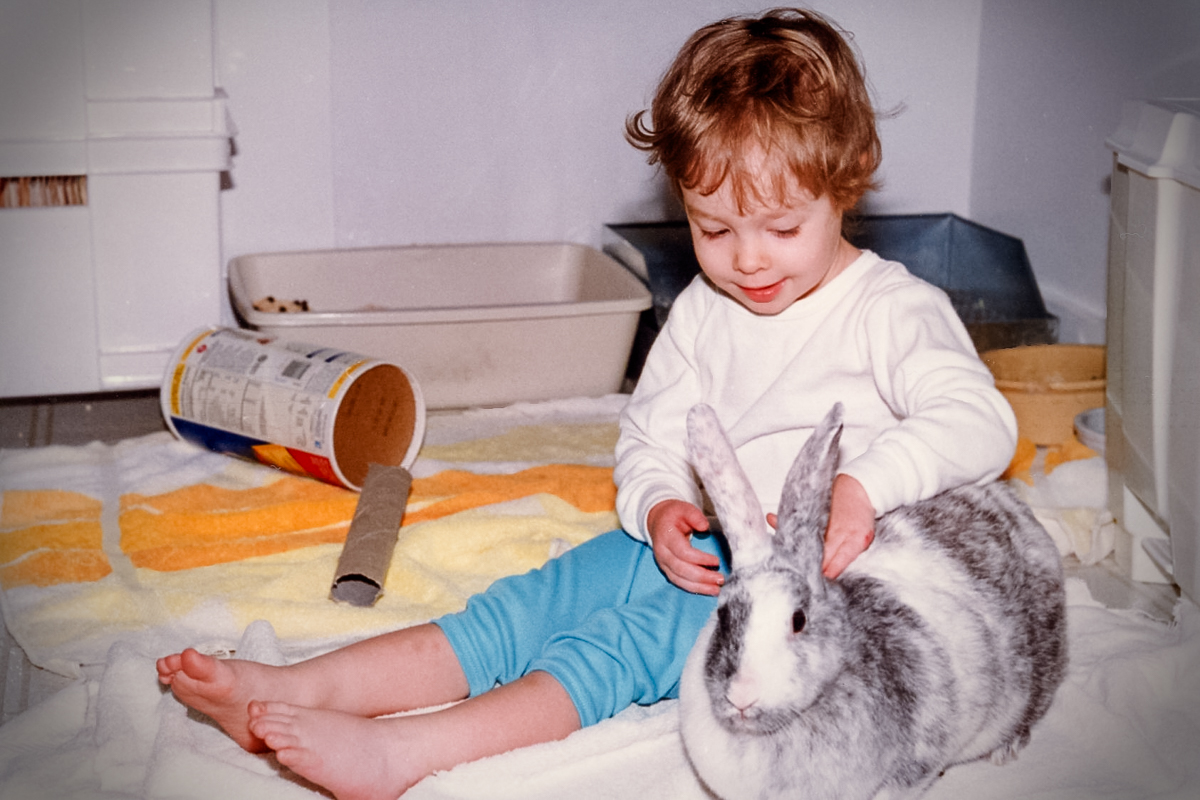“It is not easy to manage young humans and animals, but when parents find solutions, rather than dispose of an animal for convenience sake, an important concept is communicated to the child. This is alive. This is valuable. You don’t throw it away.”
– Marinell Harriman, Importance of Permanence
Thinking about welcoming a rabbit into your family, especially with children around? It’s a journey filled with potential for joy, learning, and companionship, but it also requires thoughtful consideration and understanding. Read on for more about creating a harmonious home for rabbits and children.
Video Summary: Rabbits and Children
The True Nature of Rabbits: Beyond the Storybook Image
Rabbits are often thought of as the quintessential pet for children, conjuring images of cuddly, serene creatures eager for hugs. However, the reality can be quite different. Young rabbits are energetic explorers, not always keen on being held, and their delicate nature means they need to be treated with gentle care to avoid any harm—to themselves or to their young human friends.
Rabbits have their own unique ways of expressing discomfort or fear, such as kicking or even nipping, when they feel threatened. This can be surprising and even disappointing to families expecting a more docile companion. It’s crucial to understand that rabbits communicate and show affection in their own unique ways, usually preferring to interact with their human family members on the ground, where they feel safest. Stress-related illnesses are common. For these reasons, many children, especially young children, will find it difficult to interact with a rabbit and soon lose interest.
For a rabbit to become truly part of the family and maintain optimal health, they need to live indoors and spend ample time out of their cage, interacting with the family. Keeping your rabbit confined to an outdoor hutch or predominantly inside an indoor cage will prevent your family from discovering and appreciating the rabbit’s unique character.
Rabbits Can Be Wonderful Family Members
What makes rabbits excellent companions for the home?
- Are quiet,
- Can be trained to use a litter box with great reliability,
- Are fun to watch,
- Possess individual personalities, much like dogs and cats, and
- Do not require outdoor space, thriving in indoor areas with ample sunlight for exercise
The Role of Adults in a Rabbit-Friendly Home
It’s important for parents to understand that, ultimately, the well-being of a rabbit in a family setting will rest on the adult’s shoulders. While the idea of a pet being a child’s responsibility is common, rabbits’ specific needs and sensitivities make it unrealistic for a child to be their primary caregiver. Adults must be prepared to ensure the rabbit’s living environment, diet, and routine care are consistent and suitable. Rabbits and children make sense when a parent is in charge.
Rabbits and Children: Finding Harmony
Creating a harmonious relationship between children and rabbits is possible with patience, education, and supervision. Children can learn to understand and respect the rabbit’s needs and boundaries, which can lead to a rewarding friendship. It’s about guiding children on how to interact gently and calmly with their rabbit companion, recognizing the rabbit’s signals, and knowing when to give the rabbit space.
“If your family already has a rabbit whom “children were supposed to care for” and there are problems with this, then try to reconcile yourself to the fact that a rabbit is an adult’s responsibility. Rabbits are very sensitive to changes to their feeding, cleaning, and exercise routines. Changes are stressful and may lead to illness. Symptoms of illness are often subtle changes in appetite, behavior, and/or droppings that even mature children will miss. It is unreasonable to expect a child of any age to take responsibility for care of a rabbit (or any pet). The rabbit and your children, as well as the family peace, will benefit greatly from you accepting this notion.”
Considering a Rabbit? Reflect on These 3 Key Points
Before deciding to bring a rabbit into your home, it’s vital to think about your family’s lifestyle, the amount of time and space you can dedicate to a new pet, and whether you’re prepared for the long-term commitment a rabbit requires. Remember, rabbits can live for 8-12 years and need daily interaction and care.
A Rabbit’s Home Is Inside, With You
For a rabbit to truly become part of the family, it needs to live indoors, where it can be safe and involved in daily family life. Outdoor hutches or isolated living situations can prevent the bond between your family and the rabbit from fully forming.
When thinking about rabbits and children in your home, it’s crucial for the adults to reflect on their readiness to embrace the responsibilities that come with a rabbit. Are the adults prepared to welcome the rabbit as a full-fledged family member, ensuring it lives indoors with plenty of freedom and supervised interaction? It’s important to consider whether there’s a collective understanding and willingness to learn about a rabbit’s needs, behaviors, and the commitment involved, including time, training, and financial aspects, for a duration of 5 to 10 years.
A rabbit’s well-being hinges on the adults’ genuine enthusiasm, knowledge, and dedication to their care. Without this solid foundation, opting for a plush rabbit might be a more suitable alternative.
Additional Considerations
Your Time and Patience Commitment
Achieving harmony between children and a rabbit doesn’t require you to be a superhero. However, it’s worth asking if you’re ready to welcome the equivalent of another “toddler” into your home. Rabbits and children share many similarities; they can bring immense joy, but they also require:
- Commitment to litterbox training and understanding that accidents will happen. It’s common for rabbit caregivers to accept the occasional droppings and puddles as part of marking territory.
- Efforts to make your home safe for a free-roaming rabbit, akin to childproofing, ensuring the rabbit can explore without harm.
- Regular supervision of your rabbit, especially during playtime with children, to ensure safe interactions. A minimum of three to four hours of exercise outside the cage is essential each day.
- Preparedness for potential damage to personal belongings, as a rabbit’s need to chew and dig varies with their age, personality, and whether they are spayed or neutered, as well as the types of toys provided.
- Creativity in providing toys, which can be simple and homemade, to keep your rabbit entertained.
- Establishment of a routine for feeding, play, and cleaning that suits you and your rabbit, as consistency helps prevent viewing your rabbit as just another chore.
- Understanding that positive reinforcement works best with rabbits, encouraging them to engage in desirable behaviors through praise rather than punishment.
Embracing a rabbit into your family means adapting to their needs with patience and care, much like nurturing a young child.
The Temperament of Your Child
The presence of a rabbit in your family can be more harmonious if your child naturally displays a calm, gentle, and cooperative demeanor. Such traits can foster a nurturing environment for a rabbit. On the other hand, if your child is more inclined towards high energy, loud activities, physical or aggressive interactions, or often needs guidance on following rules, establishing a bond with a rabbit might prove challenging. In such cases, adding a rabbit to the household could potentially increase stress levels.
Number of Children & Ages
Despite popular beliefs around Easter, rabbits often aren’t the best match for very young children under the age of 7. The lively and loud nature of toddlers can be overwhelming for rabbits, who prefer a peaceful environment and are not typically suited for frequent handling and cuddling like some pets.
The decision to introduce a rabbit into your home should take into account the unique personalities and ages of your children, as well as the overall dynamics of your household. While there are always exceptions, the following considerations can help guide your decision:
- Single Child Under 7 Years – It’s generally advisable to reconsider getting a rabbit unless your child is particularly calm and you, as the adult, are ready for the commitment similar to caring for another young child, with sufficient time and patience.
- Multiple Children Under 7 Years – It might be best to avoid adopting a rabbit, as your hands are likely already full, and rabbits require a calm and stable environment.
- Mixed Ages, Including Under and Over 7 Years – The possibility of adopting a rabbit depends on various factors, such as the individual temperaments of your children and the overall energy level in your home. A highly active younger child could complicate the peaceful cohabitation with a rabbit, even if an older child might be more understanding and gentle.
- Children All Over 7 Years – There’s potential for a rabbit to fit into your family, provided that the household isn’t too hectic and there’s a commitment to understanding and meeting the rabbit’s needs. However, a busy household with frequent visitors and numerous extracurricular activities might not be the ideal setting for a rabbit.
- Combination of Younger and Older Children – In busy households with both younger and older children, the challenges of providing a suitable environment for a rabbit may be too great, making it difficult to foster a close bond between your family and the rabbit.
- One Child Over 7 Years – A rabbit could be a joyful addition to your family if the child is calm, respectful, and you’re fully prepared for the responsibilities that come with rabbit care. However, a more boisterous or less rule-abiding child could mean that a rabbit might add to stress rather than joy.
In each scenario, the key lies in assessing not just the ages of your children but also their personalities, your household’s lifestyle, and your readiness as an adult to provide a nurturing environment for a rabbit.
Financial Considerations
Like any pet, owning a rabbit involves financial responsibilities that cover their living environment, diet, and healthcare throughout their life. Initial costs typically include purchasing a suitable enclosure, such as a cage or pen, starting at around $100, and potentially covering spaying ($150-$400) or neutering ($100-$300) procedures, if not already done before the rabbit joins your family. Rabbits also require yearly vaccinations for RHDv2 usually around $125. It’s important to budget for occasional veterinary visits for health issues. Additionally, ongoing expenses will include litter, pellet food, fresh vegetables, and hay to ensure your rabbit’s well-being.
Space
For the well-being, safety, and proper socialization of rabbits, it’s best to house them indoors. The minimum recommended enclosure size for a house rabbit is typically at least 12 square feet of living space, such as a 4 feet by 3 feet enclosure. However, larger is always better to ensure the rabbit has ample room to move, stretch, and play. It’s important to remember that this space should be complemented with several hours of supervised out-of-enclosure time daily for exercise and social interaction, as rabbits are active and social animals. Always aim to provide the largest space possible within your home to support your rabbit’s health and happiness. The pen should within a part of the home where the bunny can interact with family members. Additionally, when planning where your rabbit will spend time outside of their cage, opt for a space that can be easily adapted to be rabbit-safe.
Allergies
If any of your family has allergies, you should have testing done to see if there is an allergy to rabbits or hay before you get a rabbit.
Welcoming a New Baby
The arrival of a new baby in a home shared with a rabbit might mean your furry friend gets a bit less attention temporarily, but it doesn’t have to be a negative experience for either of you. While your time for extended play and cuddles might be limited, keeping up with your rabbit’s regular care routine is key. You might find moments of quiet bonding with your rabbit soothing, especially during the baby’s nap times. Your rabbit will adapt to these changes and would certainly prefer to stay with you rather than facing the uncertainties of a new home. It’s a tough reality that many pets, including rabbits, end up in shelters due to shifting family dynamics or care challenges.
As your child grows, they can provide additional interaction and companionship for your rabbit, enriching the bond within the family. This can be a positive development, provided you’re ready to guide and educate your child on lovingly interacting with and caring for their rabbit friend.
Teaching Kids to Be Rabbit People
Introducing a rabbit to your home involves mindful guidance, whether you’re welcoming a new baby or introducing the rabbit to your child. Here’s how you can foster a respectful and loving relationship between your child and the rabbit:
- Educate yourself and your child about rabbit behavior and communication, so you can help your child understand how their actions affect the rabbit.
- Choose calm moments for your child to interact with the rabbit, ensuring a positive experience for both.
- Create positive interactions between your child and the rabbit by demonstrating and guiding appropriate ways to engage, aiming to avoid constant reprimands.
- When correcting your child, focus on teaching alternative, rabbit-friendly behaviors rather than just saying “No.” This helps your child learn how to interact positively with the rabbit.
- Clarify to your child why certain actions might not be suitable for the rabbit, enhancing their empathy and understanding.
- If necessary, temporarily separate your child and the rabbit to prevent any harm, reinforcing the importance of gentle behavior.
- Designate a safe space for the rabbit that’s out of reach from young hands, using child gates or positioning the cage to allow the rabbit privacy.
- During social gatherings or when friends visit, it’s wise to keep the rabbit in a peaceful area away from the excitement, introducing the rabbit to others in controlled, quiet settings.
By guiding your child with empathy and clear instructions, you can cultivate a nurturing environment where both your child and the rabbit feel safe and valued.
Interacting with Rabbits Across Different Ages
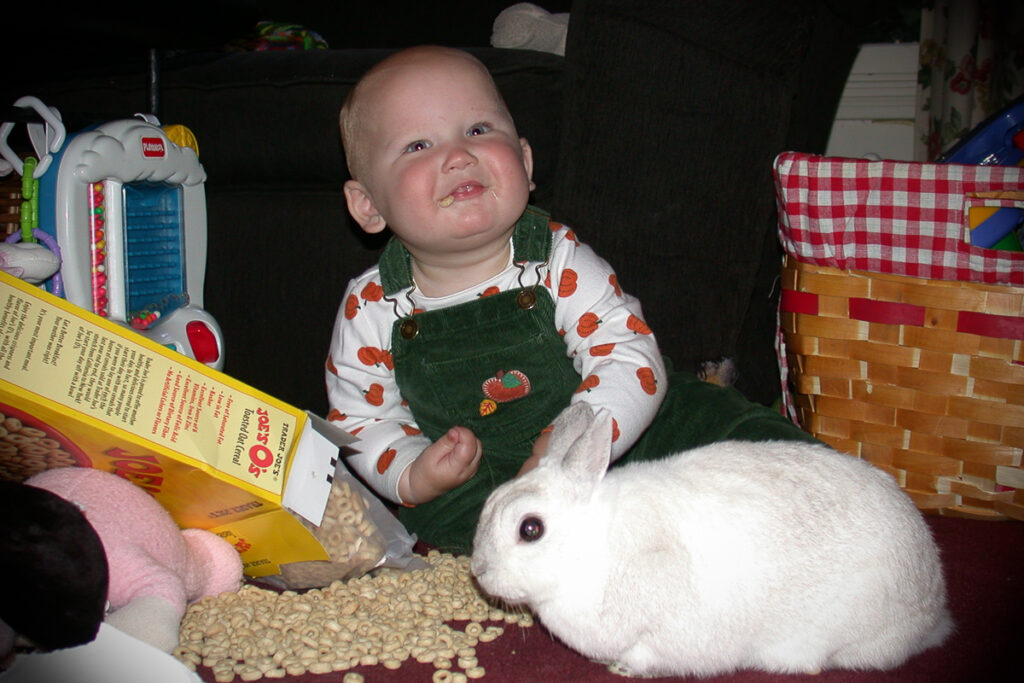
Infants (6-12 Months): Introducing Respect and Gentle Touch
Instill the concept of treating the rabbit with care and respect from an early age. Refer to “The Four BUNNYRULES” to help kids set boundaries.
- BUNNYRULE #1: Gentle petting.
Encourage soft petting by sitting with your child and gently guiding their hand over the rabbit, avoiding tight grips on the fur. - BUNNYRULE #2: Leave the rabbit alone when he hops away or goes in his cage.
Teach your child to respect the rabbit’s space, especially when it retreats to its cage or hops away, explaining that this means the rabbit needs a break. - BUNNYRULE #3: Don’t touch droppings and litter.
Highlight the importance of cleanliness by explaining that rabbit droppings and litter are not for touching, emphasizing hygiene.
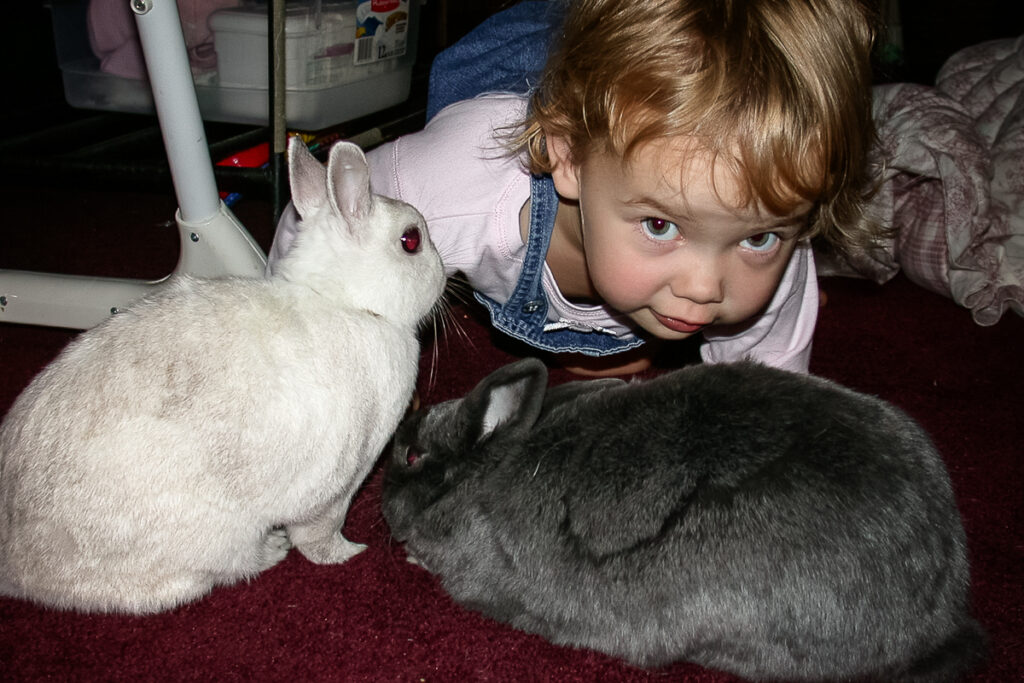
Toddlers (1-2 Years): Enhancing Understanding and Supervision
- Reinforce the initial rules and introduce the idea that rabbits are not to be picked up by children, to prevent stress or injury.
- Supervise interactions closely, guiding toddlers to recognize when the rabbit has had enough and redirecting their attention to prevent chasing or loud behaviors.
- Use this time to also educate about hygiene and the rabbit’s toilet habits, especially as toddlers may be exploring their own.
- BUNNYRULE #4: Gentle Touches Only, No picking up or Lifting
It’s important to communicate to children that picking up a rabbit can be frightening for them and might lead to injuries for both the child and the rabbit. Only adults should lift the rabbit when necessary, for example, for care or health checks. Help children understand rabbit behaviors and sounds, like the meaning behind a rabbit’s teeth clicking in enjoyment or the playful action of tossing a ball. If a child accidentally scares or hurts the rabbit, gently explain what happened and guide them on how to interact more carefully. Move noisy activities away from the rabbit’s area to keep their environment peaceful. Encourage sharing in rabbit care by allowing toddlers to assist with feeding, ensuring they give the rabbit suitable foods in appropriate amounts.
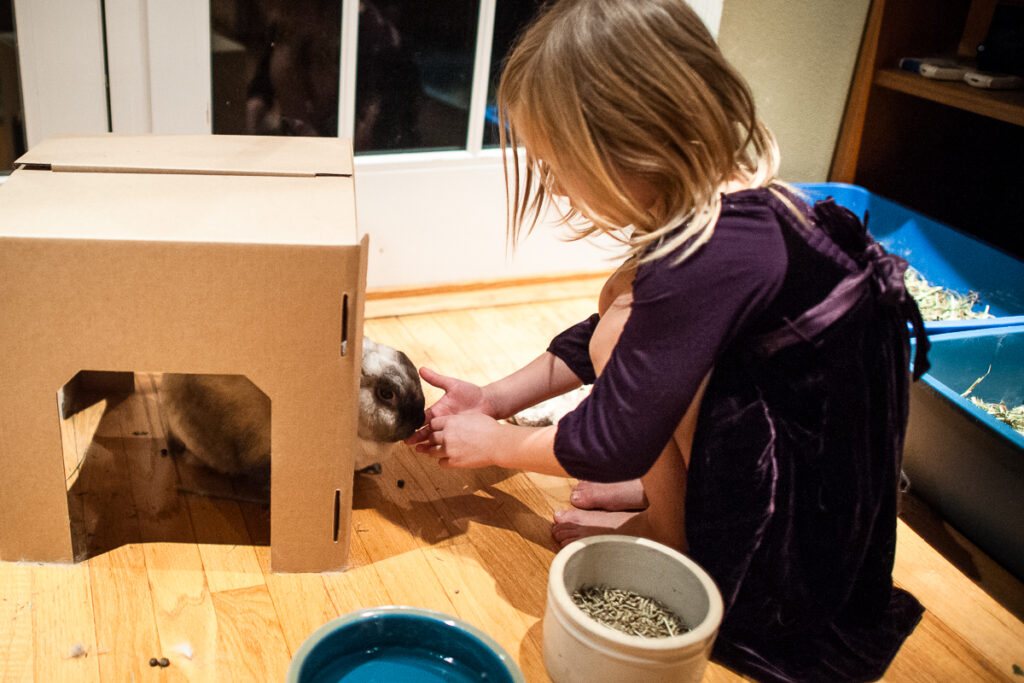
Children Aged 3 to 7 Years: Building Empathy and Involvement
- A 2-year-old who has been raised alongside a rabbit may already show considerable empathy and understanding towards the animal. It’s important to keep reinforcing BUNNYRULES #1 through 4. Focus on leading by example rather than frequently saying “No”; children often learn best through observation and mimicry of adult behavior.
- Continue to model respectful interactions between rabbits and children and, if they show interest, involve them in simple care tasks under supervision, such as feeding or providing toys.
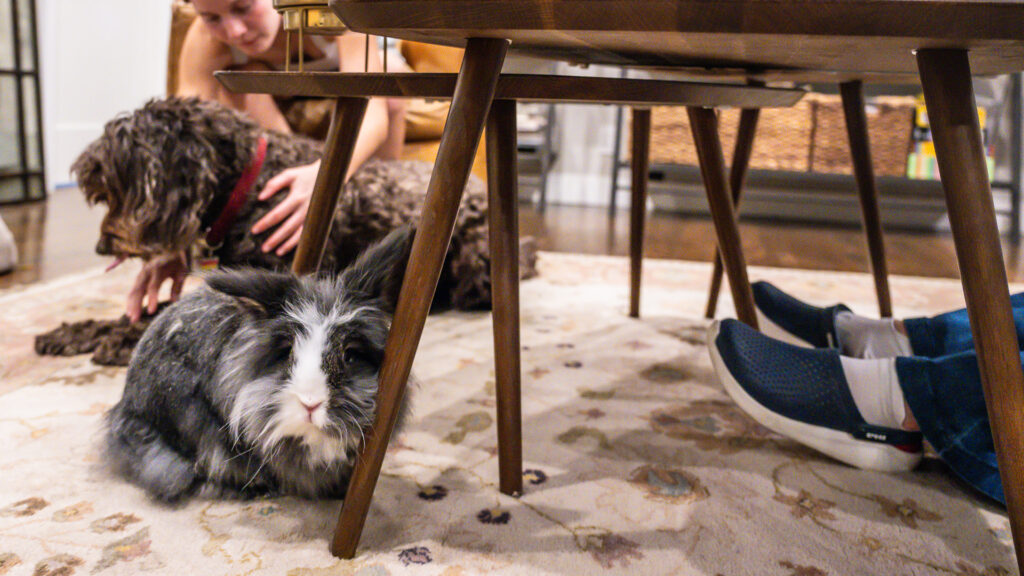
Older Children: Fostering Independence and Responsibility
- As children mature, they can take on more active roles in caring for the rabbit, with tasks suited to their age and capability. Encourage them to spend quiet time with the rabbit during their own activities, like reading or homework, to strengthen their bond.
- Maintain the principle of leading by example, showing how to treat the rabbit with kindness and respect, and ensuring that the care for the rabbit remains a shared family responsibility, with adults overseeing to ensure the rabbit’s well-being.
Across all ages, the focus should be on creating a safe, respectful, and loving environment for both the children and rabbits, with clear guidance and positive reinforcement.
Choosing a Bunny: Looking For a Good Fit
Rabbits are unique individuals, making it challenging to apply broad statements about different breeds. However, for families with children, medium to large-breed adult rabbits often make a suitable choice due to their size, which not only garners more respect from children but also facilitates easier handling and petting. On the other hand, dwarf breeds may exhibit higher levels of energy and assertiveness. Young rabbits, known for their boundless energy and tendency to nibble and chew indiscriminately, can be more demanding. Adult rabbits, particularly those that have been spayed or neutered, tend to adapt more readily to litter and house training, and their personalities are more established, aiding in the selection process.
Consider adopting a rabbit from a rescue organization or shelter, offering numerous benefits, not the least of which is contributing to the effort to reduce rabbit overpopulation. Shelters are often faced with the heart-wrenching task of euthanizing countless rabbits due to a lack of homes, many of which are still in their youth. By choosing to adopt, you provide a deserving rabbit with a loving home and take a stand against the for-profit breeding of rabbits.
Considering Responsibility: A Reflection
Many parents hope that adopting a rabbit will instill a sense of responsibility in their child. However, it’s common for children to lose interest or struggle with the consistent care needed, leading to neglect of the rabbit. This situation with rabbits and children can leave the child feeling guilty for failing to care for their pet or resentful towards the animal due to the adult’s reprimands. In some cases, the rabbit is rehomed, inadvertently teaching the child that responsibilities can be abandoned.
Instead, involve your child in caring for the rabbit without making it a requirement. Support their interest and gently guide them towards other activities if they lose enthusiasm, ensuring you continue to care for the rabbit. Children learn by example; your actions, voice, and attitude towards the rabbit teach them about compassion, patience, and the joy of respecting and caring for another life.
In Summary: A Rabbit as a Family Companion
Rabbits can bring a lot of joy and companionship to a family, but they require understanding, patience, and commitment. It’s a journey that goes beyond the initial allure of a fluffy pet, delving into mutual respect and care. If your family is ready to take on the responsibility and embrace a rabbit’s unique qualities, they can become a cherished member of the family.
Further Reading
- Rabbits and Children from The Bunny Lady
- Rabbits and Children from My House Rabbit
- Rabbits and Children from Wabbit Wiki
